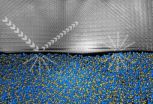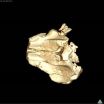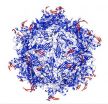(Press-News.org) Graphene, a one-atom-thick form of the carbon material graphite, has been hailed as a wonder material — strong, light, nearly transparent, and an excellent conductor of electricity and heat. But a number of practical challenges must be overcome before it can emerge as a replacement for silicon and other materials in microprocessors and next-generation energy devices.
One particular challenge concerns the question of how graphene sheets can be used in real devices.
"When you fabricate devices using graphene, you have to support the graphene on a substrate and doing so actually suppresses the high thermal conductivity of graphene," said Li Shi, a professor of mechanical engineering at The University of Texas at Austin, whose work is partially funded by the National Science Foundation (NSF).
Thermal conductivity is critical in electronics, especially as components shrink to the nanoscale. High thermal conductivity is a good thing for electronic devices fabricated from graphene. It means the device can spread the heat it generates to prevent the formation of local hot spots. However, in the case of graphene, when the needed supporting materials are also used, graphene loses some of the superhigh thermal conductivity that is predicted for its idealized state when it is freely suspended in a vacuum.
In a paper published in September 2013 in the Proceedings of the National Academy of Sciences, Shi, along with graduate research assistant Mir Mohammad Sadeghi and post-doctoral fellow Insun Jo, designed an experiment to observe the effects of thermal conductivity when the thickness of graphene supported on an amorphous glass layer was increased.
They observed that thermal conductivity increased as the number of layers grew from a single one-atom layer to as thick as 34 layers. However, even at 34 layers, the thermal conductivity had not recovered to the point where it was as high as bulk graphite, which is an excellent heat conductor.
These findings are leading Shi and others to explore novel ways of supporting or connecting graphene with the macroscopic world, including three-dimensional interconnected foam structures of graphene and ultrathin graphite, or the use of hexagonal boron nitride, which has nearly the same crystal structure as graphene.
"One of our objectives is to use graphene and other layered materials to make flexible electronic devices," Shi explained. "And those devices will be made on plastic substrates, which are flexible, but also have very low thermal conductivity. When you run current through the devices, a lot of them fail. The heat cannot be dissipated effectively, so it becomes very hot and it just melts the substrate."
Melting isn't the only problem. As temperatures get higher, the flexible polymer substrate can become a molten and rubber-like material that breaks the electronic materials built on top and causes tiny conducting wires in electronic devices to easily fail.
"In general, a hot chip is not good for the devices," Shi said. "The transistors will switch slower and will require more power."
Shi has been exploring the physical properties of graphene-based materials for more than a decade. He co-authored a 2001 paper in Physical Review Letters that reported the first measurement of high thermal conductivity in individual carbon nanotubes, a cousin of graphene. He also co-authored a 2010 paper in Science that provided critical insight into the thermal conductivity and thermal transport in single layer graphene supported on a substrate.
Shi is trying to answer fundamental questions about how phonons — the vibrations of atoms in solids — transport heat. Phonons are like electrons or photons (light particles), in that they carry heat energy. However, much less is known about phonons because their effects are less apparent at the macro-scale at which we live.
"This fundamental study allowed us to understand the intrinsic physics of the scattering of lattice waves," Shi said.
Shi's experiments let his team infer how phonons scatter as a function of thickness of the graphene layers, based on observations of how the thermal conductivity varied with different numbers of layers.
To gather these insights, his team conducted theoretical calculations using the Stampede supercomputer at the Texas Advanced Computing Center (TACC) at The University of Texas at Austin. Stampede is funded by the National Science Foundation (NSF) through award ACI-1134872.
The simulations led them to better understand their experimental results.
"To really understand the physics, you need to include additional theoretical calculations. That's why we use the supercomputers at TACC," Shi said. "When you do an experiment, you see a trend, but without doing the calculations you don't really know what it means. The combination of the two is very powerful. If you just do one without doing the other, you might not develop the understanding needed."
Most of the thermal systems used today are based on legacy technologies, according to Shi. Copper and aluminum serve as heat sink materials in computers; molten salts and paraffin wax are used as the storage medium of energy in thermal storage devices; and to perform thermoelectric conversion for waste heat recovery, we use materials like bismuth telluride or lead telluride that contain elements that are neither abundant in the earth's crust nor environmentally friendly.
"We're really limited by the materials," Shi said. "Can we come up with more effective materials to replace copper interconnects and copper heat-sinks, or replace silicon transistors? Can we develop thermally stable insulators for applications like fire protection? I think in 10 years, new materials will be discovered and implemented to replace these legacy technologies."
Recently, Shi has been exploring how multi-layered graphene can recover some of the high thermal conductivity that is lost as graphene is placed on a glass substrate, and also looking into other crystalline materials for supporting graphene
Shi and his team are experimenting and modeling new dielectric supports, like boron nitride, which has a comparable crystal structure to graphene. The hope is that its similar crystal structure will lead to better thermal conductivity and less phonon scattering when they are used to support graphene. In a recent paper in Applied Physical Letters, Shi and Steve Cronin's team at University of Southern California reported their investigation of thermal transport across a graphene/boron-nitride interface
The results suggest the importance of improving the interface quality to increase the interface's conductance.
Another line of Shi's research looks at materials for thermal energy storage. Writing in the December 2013 issue of the journal Energy and Environmental Science, Shi's team showed that ultrathin graphene foams can be used to increase the power capacity of thermal storage devices by increasing the rate that heat can be charged and discharged into the phase change materials used to store the thermal energy.
"The increased thermal cycling stability, and applicability to a diverse range of phase change materials suggests that ultra-thin graphite foam composites are a promising route to achieving the high power capacity targets of a number of thermal storage applications, including building and vehicle heating and cooling, solar thermal harvesting, and thermal management of electrochemical energy storage and electronic devices," said Michael Pettes, a professor of mechanical engineering at the University of Connecticut and co-author of the paper.
"It is Shi's fundamental work on nanoscale materials including graphene that has guided the design of scalable materials which can benefit from nanostructuring and provide possibly revolutionary societal benefits," Pettes said.
The common thread for all this research is the development of an understanding of how the fundamental energy carriers, including electrons, photons, phonons and molecules, are transported and coupled to each other in materials.
"Professor Shi has pioneered work on the measurements of phonon transport at the nano-scale and has undertaken measurements across a range of nano-scale systems," said Sumant Acharya, a program officer in the Thermal Transport Processes Program at the NSF. "He was among the first to report measurements showing the important effect of a substrate on thermal conductivity reduction in graphene."
The NSF has also supported Shi on the development of low-cost silicide thermoelectric materials with the intent of fostering the development of thermoelectric-based waste heat recovery from automobiles.
"Professor Shi is a leader in the field of nano-scale heat transport, and I am pleased that the NSF has been able to support many of Professor Shi's groundbreaking research," Acharya said.
Despite a long history exploring and designing with the material, Shi doesn't claim graphene will always be superior to other materials.
"It has exciting prospects for applications," he said. "And there's great physics involved."
INFORMATION: END
Graphene for real-world devices
New research in phonon scattering sheds more light on graphene as a replacement for silicon
2014-05-06
ELSE PRESS RELEASES FROM THIS DATE:
Cedars-Sinai researchers identify how heart stem cells orchestrate regeneration
2014-05-06
LOS ANGELES (EMBARGOED UNTIL NOON ET ON MAY 6, 2014) – Investigators at the Cedars-Sinai Heart Institute – whose previous research showed that cardiac stem cell therapy reduces scarring and regenerates healthy tissue after a heart attack in humans – have identified components of those stem cells responsible for the beneficial effects.
In a series of laboratory and lab animal studies, Heart Institute researchers found that exosomes, tiny membrane-enclosed "bubbles" involved in cell-to-cell communication, convey messages that reduce cell death, promote growth of new heart ...
Redescription of the oldest-known dolphin skull sheds light on their origins and evolution
2014-05-06
VIDEO:
This is the CT image of the skull of the holotype of Eodelphis kabatensis.
Click here for more information.
Dolphins are the most diverse family of living marine mammals and include species such as the bottlenose dolphin and the killer whale. However, their early evolution and fossil record has been steeped in mystery due to lack of good specimens. A new paper published in latest issue of the Journal of Vertebrate Paleontology re-describes the oldest species of dolphin ...
One step closer to cell reprogramming
2014-05-06
In 2012, John B. Gurdon and Shinya Yamakana were awarded the Nobel Prize in medicine for discovering that adult cells can be reprogrammed into pluripotent ones (iPS); the cells obtained are capable of behaving in a similar way to embryonic stem cells, and hence have enormous potential for regenerative medicine.
However, although there are many research groups around the world studying this process, it is still not completely understood, it is not totally efficient, and it is not safe enough to be used as the basis for a new cell therapy.
Now, researchers at the Centre ...
Can you tell a person's gender by their video game avatar?
2014-05-06
This news release is available in French.
Montreal, May 6, 2014 — A sexy wood elf with pointy ears. A hulking ogre with blue skin. An intimidating heroine with a buxom breastplate. When it comes to computer games, players can choose to be anyone or anything. But gamers don't always mask their true identities with online avatars.
According to a new study by researchers at Concordia University, Colorado State University, Syracuse University, Hofstra University and the University of Toronto, a male gamer who chooses to play as a female character will still display ...
The Red Sea -- an ocean like all others, after all
2014-05-06
Pacific, Atlantic and Indian Ocean, with the land masses of the Americas, Europe, Asia, Africa and Australia in between – that's how we know our earth. From a geologist's point of view, however, this is only a snapshot. Over the course of the earth's history, many different continents have formed and split again. In between oceans were created, new seafloor was formed and disappeared again: Plate tectonics is the generic term for these processes.
The Red Sea, where currently the Arabian Peninsula separates from Africa, is one of the few places on earth where the splitting ...
Protein molecule may improve survival in deadly lung disease
2014-05-06
Researchers at the University of Illinois at Chicago College of Medicine have discovered a protein molecule that seems to slow the progression of pulmonary fibrosis, a progressive lung disease that is often fatal three to five years after diagnosis.
The finding is reported in the American Journal of Respiratory and Critical Care Medicine.
Nearly five million people worldwide are affected by pulmonary fibrosis, which causes the lungs to become covered in fibrous scar tissue and leads to shortness of breath that gets more severe as the disease progresses.
Chronic inflammatory ...
Two-lock box delivers cancer therapy
2014-05-06
Rice University scientists have designed a tunable virus that works like a safe deposit box. It takes two keys to open it and release its therapeutic cargo.
The Rice lab of bioengineer Junghae Suh has developed an adeno-associated virus (AAV) that unlocks only in the presence of two selected proteases, enzymes that cut up other proteins for disposal. Because certain proteases are elevated at tumor sites, the viruses can be designed to target and destroy the cancer cells.
The work appears online this week in the American Chemical Society journal ACS Nano.
AAVs are ...
Donor livers preserved and improved with room-temperature perfusion system
2014-05-06
A system developed by investigators at the Massachusetts General Hospital (MGH) Center for Engineering in Medicine (CEM) and the MGH Transplant Center has the potential to increase both the supply and the quality of donor organs for liver transplantation. In their report, which has been published online in the American Journal of Transplantation, the research team describes how use of a machine perfusion system delivering a supply of nutrients and oxygen though an organ's circulation at room temperature preserved and improved the metabolic function of donor livers in a ...
Study: Concussion rate in high-school athletes more than doubled in 7-year period
2014-05-06
COLUMBUS, Ohio – Concussion rates in U.S. high-school athletes more than doubled between 2005 and 2012, according to a new national study using data on nine team sports.
Overall, the rate increased from .23 to .51 concussions per 1,000 athlete exposures. An athlete exposure is defined as one athlete participating in one competition or practice.
The increase might appear to sound an alarm about sports safety, but the researchers suspect the upward trend in reported concussions reflects increased awareness – especially because the rates went up the most after the 2008-09 ...
Childhood obesity trends -- not time to celebrate, yet
2014-05-06
New Rochelle, NY, May 6, 2014—Despite reports in the media that the obesity rate among young children has declined dramatically during the past 10 years, that is not the conclusion reached by recent studies published in the medical literature. Those studies did, however, reveal some potentially encouraging findings, which are detailed in the Editorial "Childhood Obesity Trends: Time for Champagne?" published in Childhood Obesity, a peer-reviewed journal from Mary Ann Liebert, Inc., publishers. The article is available free on the Childhood Obesity website at http://www.liebertpub.com/chi.
"The ...
LAST 30 PRESS RELEASES:
Tracing the quick synthesis of an industrially important catalyst
New software sheds light on cancer’s hidden genetic networks
UT Health San Antonio awarded $3 million in CPRIT grants to bolster cancer research and prevention efforts in South Texas
Third symposium spotlights global challenge of new contaminants in China’s fight against pollution
From straw to soil harmony: International team reveals how biochar supercharges carbon-smart farming
Myeloma: How AI is redrawing the map of cancer care
Manhattan E. Charurat, Ph.D., MHS invested as the Homer and Martha Gudelsky Distinguished Professor in Medicine at the University of Maryland School of Medicine
Insilico Medicine’s Pharma.AI Q4 Winter Launch Recap: Revolutionizing drug discovery with cutting-edge AI innovations, accelerating the path to pharmaceutical superintelligence
Nanoplastics have diet-dependent impacts on digestive system health
Brain neuron death occurs throughout life and increases with age, a natural human protein drug may halt neuron death in Alzheimer’s disease
SPIE and CLP announce the recipients of the 2025 Advanced Photonics Young Innovator Award
Lessons from the Caldor Fire’s Christmas Valley ‘Miracle’
Ant societies rose by trading individual protection for collective power
Research reveals how ancient viral DNA shapes early embryonic development
A molecular gatekeeper that controls protein synthesis
New ‘cloaking device’ concept to shield sensitive tech from magnetic fields
Researchers show impact of mountain building and climate change on alpine biodiversity
Study models the transition from Neanderthals to modern humans in Europe
University of Phoenix College of Doctoral Studies releases white paper on AI-driven skilling to reduce burnout and restore worker autonomy
AIs fail at the game of visual “telephone”
The levers for a sustainable food system
Potential changes in US homelessness by ending federal support for housing first programs
Vulnerability of large language models to prompt injection when providing medical advice
Researchers develop new system for high-energy-density, long-life, multi-electron transfer bromine-based flow batteries
Ending federal support for housing first programs could increase U.S. homelessness by 5% in one year, new JAMA study finds
New research uncovers molecular ‘safety switch’ shielding cancers from immune attack
Bacteria resisting viral infection can still sink carbon to ocean floor
Younger biological age may increase depression risk in older women during COVID-19
Bharat Innovates 2026 National Basecamp Showcases India’s Most Promising Deep-Tech Ventures
Here’s what determines whether your income level rises or falls
[Press-News.org] Graphene for real-world devicesNew research in phonon scattering sheds more light on graphene as a replacement for silicon





